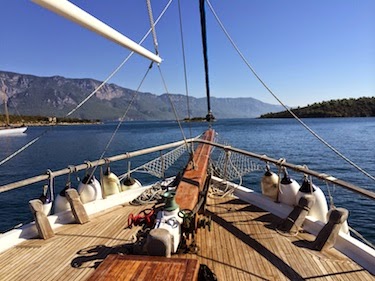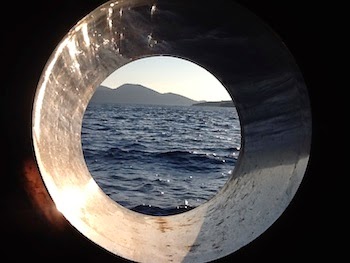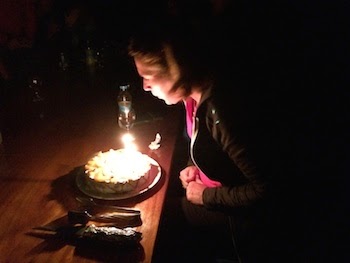Day 3 (Monday) – Despite having been awakened in the middle of the night by the necessity to reposition our boat, we woke up wide-eyed at 7:30 and found our typical Halilaga breakfast waiting for us at 8:30. We’d come to love the wonderful simplicity of yogurt, honey, bread, and coffee before the week was up. The skies were clear and blue, an incredibly invigorating azure, and the wind was subsiding, though not yet done. Conversation over breakfast was about the weather and the move in the middle of the night.
We were underway at 9:30, heading (we hoped) for a spot out of the wind. Continuing eastward along the northern side of the Gulf, we pulled into a mountain-ringed scrubby-pine inlet, typical for the Turkish coast. The wind was all but calmed, and despite our fellow passengers assuring us the water was “warm”, our toe-testing indicated otherwise. We enjoyed lunch there, battling bees from the nearby shore. Seems all that Turkish honey comes with a price: we’d be shooing honey bees every time we’d drop anchor near shore that week. It was a nervous shooing at first, but as the week progressed we’d all get a little more used to the presence of bees, and only a few of us would get stung (Lori being one, as you’ll soon see).
After lunch we moved down the coast and pulled in near the village of Çökertme, where we’d stay for the night. We enjoyed a Turkish red wine–the label called it Mystik–before and during dinner. Like most cruises, drinks are extra, but we found the prices reasonable; some of our fellow passengers who had taken Blue Cruises before remarked that the prices were higher, which seems inevitable to us.
After dinner we enjoyed conversation, particularly with our new Danish friends Karsten and Luna (you’ll remember it’s actually spelled Lone, but I’ll go with the more phonetic spelling). Karsten had been a carpenter, Luna was a cancer-surviving artist, and together they had run a wine-importing business. They owned a place in Turkey just up the coast, so had spent a good bit of time on the Turkish Aegean. Luna, endearingly had no fear of speaking English, though she often turned to Karsten to translate a word or phrase or to verify a fact for her. By the end of the week, he had rightfully earned the nickname “Mr. Google”. Luna’s accent was musical to us and an endless supply of smiles. Should you ever find yourself in conversation with a Danish woman, try your best to get her to say the word “Boogie”, and if you’re really brave, ask her if she knows what Spam (the canned meat) is.
Day 4 (Tuesday, and Lori’s Birthday) – As it turns out, we had three birthdays onboard the Halilaga this week: Lori’s on Tuesday and Jan and Jeansa’s on Wednesday. There would be no sleeping in for Lori’s birthday: with lots of miles to cover, our captain cranked up the engine at 5:00am and we were underway a few hours before we rolled out of bed. By the time we did, we were pulling up to Cleopatra Island, an island dotted with ancient ruins and where, purportedly, Cleopatra had Egyptian sand brought in to make a beach. Still, I let Lori sleep in as much as possible, and she was the last on deck for breakfast, greeted by Luna leading the passengers and crew in singing “Happy birthday to you”.
We enjoy learning a bit of the local language, and we try to be like Luna: unafraid to use what we know, as embarrassing as it might sometimes feel. So before we left for this cruise, we had indulged the friendliness of a waiter at a restaurant in Bodrum to learn the most basic of polite phrases: “thank you” and “you’re welcome”. I’ll tell you this: Turkish is a challenging language. Our waiter had to write the phrases down, and even then the pronunciations took practice. I practiced saying thank you–“TESH-Ek-Kuh-Loor”–whenever Yilmoz brought us drinks or picked up our plates. Before long he would simply smile and proactively tell me thank you (in Turkish) whenever we passed on the boat. I imagine I had earned the nickname “Thank You” amongst our crew. I would only master the response–“Air-REECH Ed-Uh-May” (you’re welcome)–the last few days of the cruise.











